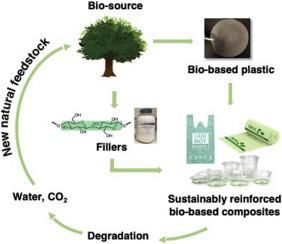Progress in Polymer Science ( IF 26.0 ) Pub Date : 2020-02-07 , DOI: 10.1016/j.progpolymsci.2020.101221 Céline Calvino , Nicholas Macke , Ryo Kato , Stuart J. Rowan

|
Plastic pollution concerns have catalyzed research into green materials with the specific goal of accessing new bio-derived and bio-degradable polymers with improved property profiles. One way to achieve these new materials is through the incorporation of nanofillers into bio-based polymer matrices. Cellulose nanocrystals (CNCs), which are extracted from biomass, have been investigated as one route to bio-based composites with enhanced performance. The combination of the excellent reinforcement capabilities of these bio-derived, nanosized particles along with relatively low production cost and biodegradability makes cellulose-based nanocomposites an attractive and promising approach to the next generation of green materials. Discussed herein is an overview of the use of CNCs to access reinforced bio-based nanocomposites, with particular focus on bio-available polyester and polysaccharide matrices. The characteristic changes provided by the incorporation of the nanofillers into the bio-based materials and their advantages and drawbacks are discussed. Specifically, the different parameters influencing mechanical reinforcement and barrier properties, such as the nature of processing, use of additives or CNC surface modifications are reviewed. Finally, the benefits of using CNC fillers in a number of potential future application areas, including polymer compatibilization, water purification, biomedical and electronics are outlined.
中文翻译:

生物来源的纤维素纳米晶体复合材料的开发,加工和应用
对塑料污染的关注促进了对绿色材料的研究,其特定目标是获得具有改进性能的新型生物衍生和可生物降解的聚合物。实现这些新材料的一种方法是将纳米填料结合到生物基聚合物基质中。从生物质中提取的纤维素纳米晶体(CNC)已被研究为获得性能增强的生物基复合材料的一种途径。这些生物来源的纳米级颗粒的出色补强能力与相对较低的生产成本和生物降解性相结合,使纤维素纳米复合材料成为下一代绿色材料的诱人且有前途的方法。本文讨论的是使用CNC来访问增强型生物基纳米复合材料的概述,特别关注生物可利用的聚酯和多糖基质。讨论了通过将纳米填料掺入生物基材料中而提供的特性变化及其优缺点。具体来说,回顾了影响机械增强和阻隔性能的不同参数,例如加工的性质,添加剂的使用或CNC表面改性。最后,概述了在许多潜在的未来应用领域中使用CNC填料的好处,包括聚合物相容性,水净化,生物医学和电子学。综述了影响机械增强和阻隔性能的不同参数,例如加工的性质,添加剂的使用或CNC表面改性。最后,概述了在许多潜在的未来应用领域中使用CNC填料的好处,包括聚合物相容性,水净化,生物医学和电子学。综述了影响机械增强和阻隔性能的不同参数,例如加工的性质,添加剂的使用或CNC表面改性。最后,概述了在许多潜在的未来应用领域中使用CNC填料的好处,包括聚合物相容性,水净化,生物医学和电子学。











































 京公网安备 11010802027423号
京公网安备 11010802027423号